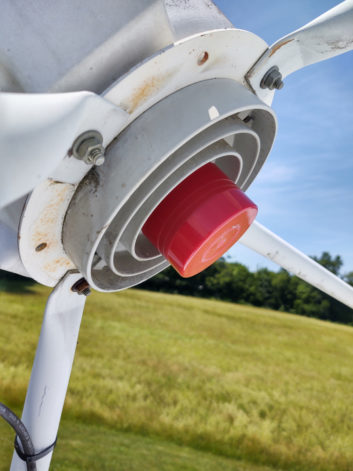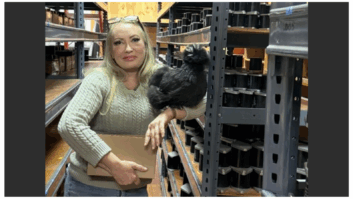
Steve Tuzeneu is a longtime broadcast engineer and Workbench contributor, and the general manager and CE of WIHS(FM) in Middletown, Conn.
Steve had a problem: a lost satellite signal; but he was able to track the problem to wasps that had taken up residence in the feed horn.
After removing them and their nest from the throat of the feed horn, Steve wanted to stop them from coming back. Fig. 1 shows Steve’s solution: a plastic cap from a used can of aerosol glue. The cap happens to fit nicely into the feed horn, discouraging any insects from moving in.
Keep this solution in mind, especially if you suddenly lose your satellite signal. As a contractor, I once was called to a station that reported losing its satellite signal every evening at sundown. Yep, you guessed it: Bees had taken up residence; during the day they were mostly away from the nest, but at night they all returned, and their combined body mass was enough to disrupt the signal.
Whether it’s a plastic cap or a cut-down 1-liter plastic water bottle, Steve’s tip will save you a headache and maybe prevent you from getting stung.
Analog at the Edge
I got a followup from engineer Dale Lamm about the AoIP EAS adapter we discussed here in July.
“I’ll confess, when I first saw the tip about the AoIP/EAS interconnection, I thought it was an April Fool’s article that was somehow delayed,” he wrote.

The CATV F connector adapting to an RJ-45 Ethernet plug was something he had never encountered. A clever engineer from WETA found this adapter and used it to solve a problem that had nothing to do with CATV.
But where did this odd adapter come from in the first place?
It starts with someone who wanted to install a TV set in a room that had nothing in the wall but Ethernet category wiring. There was no RG-6 coaxial wiring in the room.
With a pair of these adapters, you take RF from the CATV distribution amp and send it on one of the twisted pair inside the category cable.
In the room, another adapter takes it to an F connector that is attached to the TV. The 100-ohm twisted pair is close enough to the 75-ohm RG-6 impedance for this to work. Obviously, use a direct category cable connection. Don’t expect to shove RF through a network router!
Looking closely at the picture in our original article, it seems only the first pair is used. Moving consumer S/PDIF to professional AES with this adapter solved a problem inexpensively.
Dale’s plant makes partial use of audio over IP but has a lot of gear with analog I/O. He was never a big fan of dongles with twin XLR connectors hanging off the back of a dense array of rack gear. He finds it easier to modify a LAN cable — cut off one end, fan out the four pairs and solder the left/right pairs to a couple of XLRs that plug into the analog gear.
Use some tubing or heat shrink to make it pretty and more durable. Running balanced analog through 10 or 20 feet of unshielded category cable is fine.
[Check Out More of Workbench Here]
If you use the hanging dongle method, you’ll be soldering an XLR at each end of the interconnection. Dale’s method requires an XLR only at the analog equipment end, and results in less wiring congestion. Less dense rack wiring can save time troubleshooting in the future.
Note that LAN patch cables use stranded wire instead of solid if you’re concerned about flexure.
Someday, everything will be AoIP-ready or shrunken into a piece of software inside a server. For now, we all have to deal with analog at the edges of our facilities.
Ouch Ouch Ouch
Dale “Squeak” Porray, AD7K, really liked Bill Weeks’ submission about the LED replacement for fluorescent Circline bulbs but says the website link we gave may not have been right in some versions of the story. It is www.mpja.com for Marlin P. Jones Associates.
The site now has over 60 YouTube videos of the products they sell. Squeak has been dealing with them since the 1970s and says they’re a fine company.
Since we also were talking about Cat-5/6 Ethernet cables, watch the site’s YouTube video about the LAN RJ Plug Crimp Tool. It has a built-in cable continuity tester to check cables you’ve crimped, all for under $30. One notable feature is a ratchet release pin, very important!
Once while helping an engineer crimp cables, we took a break, but as we chatted, he inadvertently put his index finger in the jaws of the crimping tool and pressed down. CLICK — the jaws latched. And there was no release.
I drove him to the emergency room to get his finger freed. Since witnessing that, I’ve made sure that any latching pliers or crimping tools I use have a release pin. You can’t be too careful.
Bee a pal! Help fellow engineers by sending in your tips to [email protected].
John has spent over 50 years in broadcasting and is in his 31st year of Workbench. He handles western U.S. radio sales for the Telos Alliance and is a past recipient of the SBE’s Educator of the Year Award.







